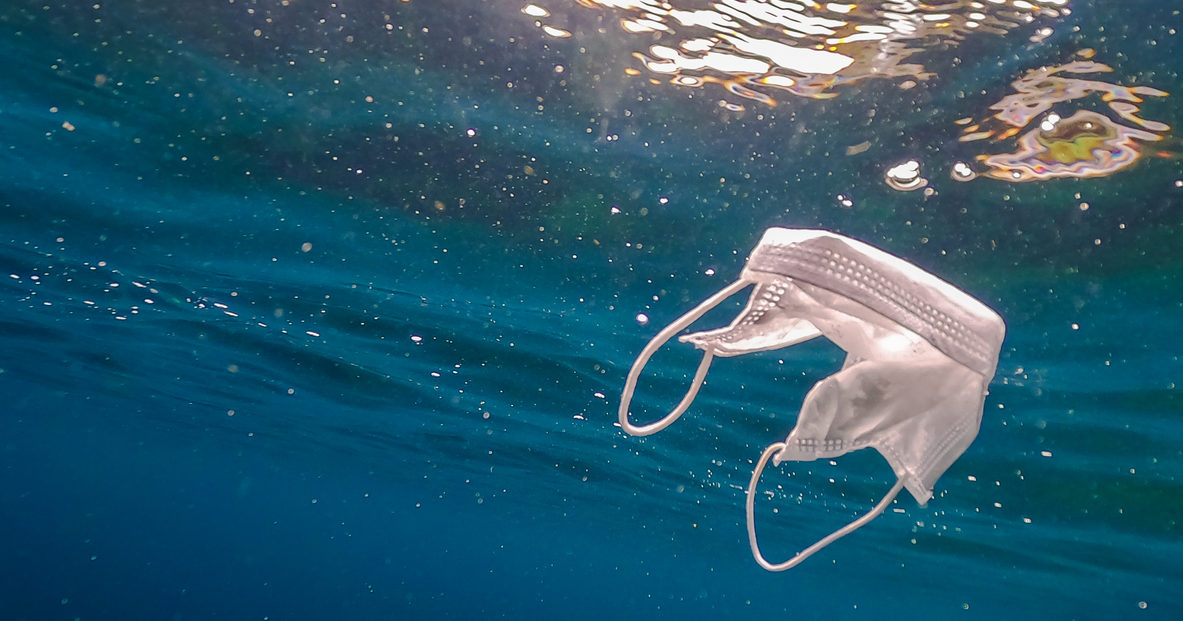At the beginning of the pandemic, it was unclear how COVID-19 spread. The CDC made conservative recommendations to keep the public safe. Reusables were out, and disposable were in. Canvas totes were barred from markets, grocery stores, and bodegas. Latex gloves, single-use face masks, and miniature bottles of hand sanitizer were stuffed into every purse and pocket. Our intentions were good; we wanted to keep ourselves and others safe. Still, there are pros and cons to many things in life—COVID-19 era disposables included.
More than a year into the pandemic, we’re being haunted by the masks, gloves, and bags we’ve used in excess. They’re showing up mangled and murky in masses around the world. Now that there are vaccines for COVID-19, we should consider finding a remedy for the single-use habit we’ve become so comfortable with.
Concentrated Pollution Progress
One year ago, we looked at the sky. media outlets from National Geographics to Newsweek reported an impressive drop in air pollution. Stars could be seen in the night sky, and people no longer blamed smog for breathing issues. Masks became the more likely culprit.
Sources reported a drop in nitrogen oxide emissions and traffic emissions in urban environments. The improvement in air quality could be seen from space. It was so inspiring that several businesses and regulatory parties insisted on implementing stricter air pollution guidelines. These parties could see that the change was due to less production and fewer people working. They knew it would not be sustainable without a framework to support the importance of air quality.
Efforts to improve air quality should not be discounted or discontinued, but it’s essential to recognize that air pollution is just one of many forms! Pollution should instead be looked at holistically with each form, air, land, and water, being given equal importance. If you don’t think there’s a problem with single-use plastics, masks, and other COVID-19 paraphernalia, you may consider taking a close look at parking lots, sidewalks, and lawns, many of which are strewn with plastic gloves, bags, and masks.
Single-Use Plastics Skyrocket
The healthcare industry uses a whooping 65 billion pairs of disposable gloves and double that number of masks in one month; that’s 780 billion pairs of gloves and 1.5 trillion masks used in a year. These figures don’t include the masks and gloves used by the general public or other industries.
Pandemic-related waste is not confirmed to PPE items. Due to confusion surrounding how COVID-19 spread during its onset, many restaurants switched to take-out only. Plastic containers and utensils ran rampant. Even with numbers leveling and restaurants opening, plastic cutlery became a staple. According to the International Solid Waste Association, single-use plastics consumption has tripled since March 2020.
Microplastics Mean Macro Health Concerns
This plastic pollution is not contained to the land; it’s carried to waterways where it traps wildlife. Discarded masks have been found around the necks of dead birds and hedgehogs. Fish have been found trapped in washed-up latex gloves. More significant effects of this plastic pollution may not be seen for some time. Once the plastics begin to break apart, they’ll become microplastics, which can cause more issues.
Microplastics come attached to products that are packaged in plastics. It is difficult to avoid these products unless you consume a whole food diet. For many, such a diet is often not affordable or accessible. Alarming amounts of microplastic have also been found in waterways and seafood. Because of their name, it can be easy to think the average person isn’t ingesting that much of them. This couldn’t be further than the truth, however. In one week, the average person consumes enough microplastics that with it, they could make a credit card.
Plastic contains a number of harmful chemicals that, when broken down and ingested, have the power to leech beyond the gut walls of living creatures. Ingesting microplastics can cause reproductive issues; they can enter the lungs or bloodstream, causing cancer and clots. While disposable masks may not be to blame, the latex gloves and return to plastic bags may be.
The Science of Harboring Better Habits
Perhaps we should consider our reignited love for plastic bags, cutlery, and other items as a bad habit we need to break. According to many scientific studies on forming habits, it takes about 60 days to form a new habit; the easier it is to make it a habit, the greater the odds it sticks and becomes routine. In terms of reducing single-use items during COVID-19, consider replacing disposable face masks with several fabric ones. This can be both a fashionable and economical option.
A second habit you can work to build is to use reusable grocery bags. Leaving a stash of them in your car, front door, or other accessible location can help increase the odds that you enter the store with them in tow. If you live in an urban environment or often pick up groceries while out doing other errands, you may consider purchasing packable reusable totes. There are many affordable options that take up little space—they can fit easily in pockets, purses, or backpacks.
If reusable masks and gloves are unavoidable—as may be the case for healthcare professionals—you can still do something to help the environment. Remember when the public was encouraged to cut apart six-pack rings holding drinks together? This suggestion followed images and new reports about marine life getting stuck in them. You can mimic these actions to help save animal lives by cutting the ear loops of disposable masks and cutting disposable gloves into smaller pieces. While these items may still find their way out of the landfill, they don’t risk killing wildlife.
While fabric alternatives can replace paper masks and plastic bags, there is still the question of an equal replacement for latex gloves. In the winter months, many experimented with cloth and leather gloves which served dual purposes of safety and warmth. With the CDC announcing that COVID-19 does not spread on surfaces or through touch but rather through nasal droplets, plastic gloves should no longer be necessary outside the healthcare setting.






